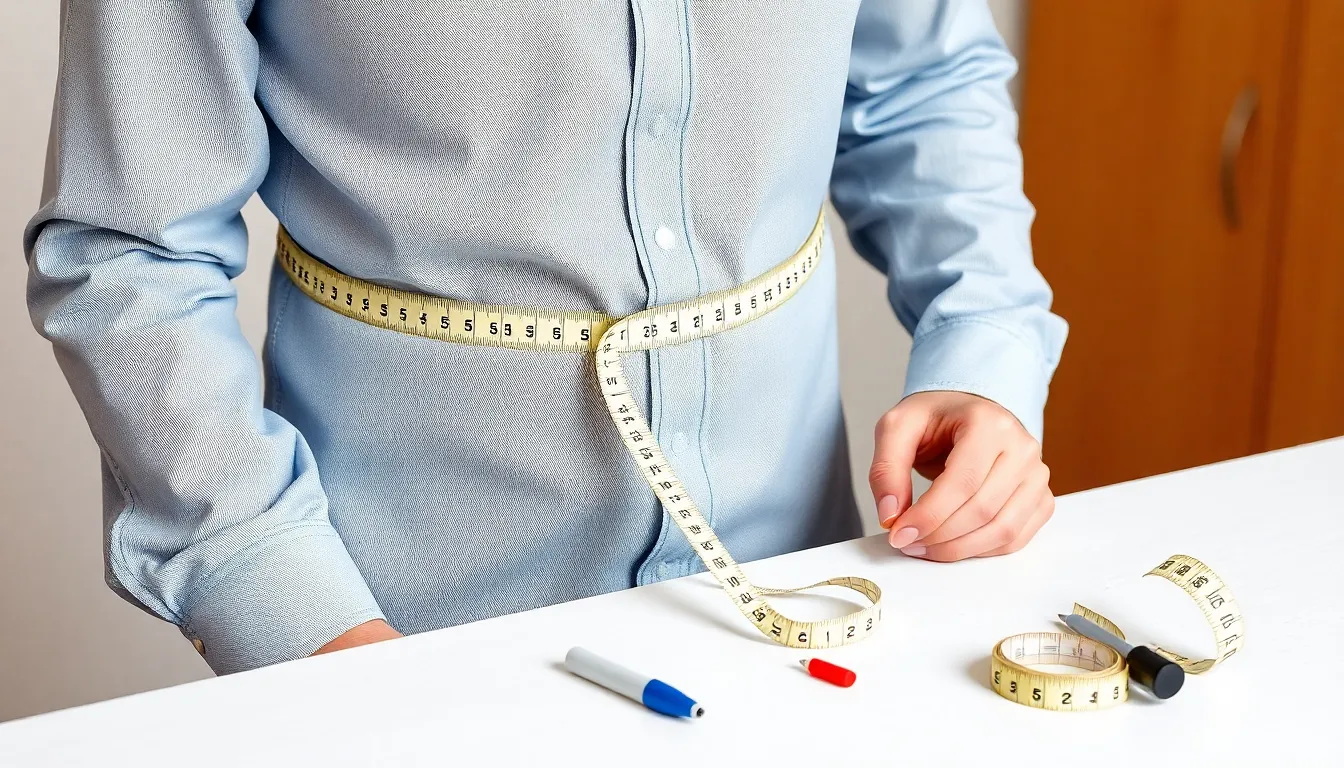Table of Contents
ToggleFinding the perfect dress shirt can feel like searching for a needle in a haystack. With so many styles and fits out there, it’s easy to get lost in the fabric jungle. But fear not! Measuring for that ideal shirt doesn’t have to be a daunting task. In fact, it can be as simple as measuring your waistline—if your waistline were a sophisticated, tailored masterpiece waiting to happen.
Imagine strutting into a room, looking sharp and feeling comfortable, all because you took a few minutes to measure yourself correctly. No more awkward tugging or feeling like a stuffed sausage! With the right measurements, you can unlock a world of stylish possibilities. So grab a tape measure and let’s dive into the art of measuring for a dress shirt that fits like a dream.
Importance Of Accurate Measurements
Accurate measurements play a crucial role in achieving the right fit for a dress shirt. Ill-fitting shirts can lead to discomfort, affecting confidence throughout the day. The difference between a tailored and a loose shirt often lies in precise measurements.
Using a tape measure correctly ensures that the dimensions align with body shape and size. Each body type varies, making it essential to understand these variations when measuring. Key areas to focus on include neck size, chest width, and sleeve length.
When neck size is measured, it’s vital to leave enough room for comfort while ensuring it’s not overly loose. Chest width requires measuring around the fullest part of the chest, allowing for movement without constriction. Sleeve length, measured from the shoulder to the wrist, contributes significantly to overall appearance.
Miscalculations in these areas can result in shirts that are too tight or too baggy. A snug fit across the shoulders enhances mobility and style. Taking the time to measure correctly prevents the need for frequent alterations or returns.
Measurements also help in selecting the right size within brands, since sizes may vary slightly between manufacturers. Understanding size charts specific to brands aids in making informed decisions. Simple, accurate measurements can transform the overall look, making it more polished and professional. Trust in proper measurements to elevate the wardrobe and provide greater satisfaction with each wear.
Essential Tools For Measuring

Accurate measurements for a dress shirt require specific tools to achieve the best results. Using the right instruments can make the process easier and yield more reliable data.
Measuring Tape
A flexible measuring tape is essential for taking measurements. This tool allows for precise measuring of the neck, chest, and sleeves. It’s crucial to keep the tape straight and snug against the body without pulling too tightly. Measurements recorded should reflect the natural contours. Look for a cloth or plastic measuring tape that extends to at least 60 inches for convenience. Avoid metal tapes as they can be rigid and less suited for body measurements. Take notes as each measurement is obtained to ensure accuracy.
Fabric Marker
A fabric marker aids in marking measurement points for adjustments. This tool allows for clear and precise indications on the fabric. Use it to denote areas like the shoulder seam or the desired hemline. Select a fabric marker that easily washes out or disappears over time to prevent unwanted stains. Marks should be visible without being permanent. Ensure the marker’s color contrasts well with the fabric for clarity. Recheck measurements before making any permanent alterations to ensure the best fit.
Key Measurements For Dress Shirts
Accurate measurements are essential for achieving the ideal dress shirt fit. Key areas to measure include neck size, chest width, sleeve length, waist measurement, and shirt length.
Neck Size
Neck size determines how comfortably a shirt fits around the collar. To measure, wrap a flexible tape measure around the base of the neck. Ensure the tape is snug but not tight, allowing for breathing room. Record the measurement in inches. Sizes often range from 14 inches to 18 inches, with half-inch increments common among different brands.
Chest Width
Chest width influences the overall shape and fit of the shirt. Measuring involves wrapping the tape measure around the widest part of the chest, right under the armpits. It’s important to keep the arms relaxed at the sides during this measurement. Write down the size, typically varying from 34 inches to 52 inches, for a comfortable fit across various styles.
Sleeve Length
Sleeve length affects the arm’s mobility and the shirt’s appearance when worn. Start measuring from the center back of the neck to the shoulder’s edge, then down to the wrist. This approach ensures the sleeve is the correct length to avoid any discomfort when reaching forward. Sleeve lengths generally range from 32 inches to 38 inches, depending on the total arm length.
Waist Measurement
Waist measurement plays a crucial role in fitting the shirt properly. Measure around the natural waist, just above the hip bones. The tape should fit snugly without causing any discomfort. A proper measurement in this area supports a tailored appearance. Waist sizes can vary significantly, from 28 inches to 40 inches or more.
Shirt Length
Shirt length impacts how the shirt fits into trousers and overall style. To measure, start from the top of the shoulder and go straight down to the desired point, typically just below the hips. This length maintains a polished look while ensuring comfort without excess fabric. Standard shirt lengths often range from 28 inches to 34 inches, depending on the style and fit.
Common Mistakes To Avoid
When measuring for a dress shirt, a few common mistakes can lead to poor fit and discomfort. Identifying and avoiding these errors ensures a better overall experience.
Incorrect Measurement Techniques
Mistakes often occur with measurement techniques. Wrapping the tape too loosely results in inaccurate readings. Measuring over thick clothing leads to added bulk, affecting the fit. Some people forget to stand straight while measuring, which can also impact accuracy. Failing to measure at the correct points yields unreliable data. Using clear instructions allows for correct placement of the tape, improving measurement precision.
Using Inaccurate Tools
Using the wrong tools complicates the measuring process. A flexible measuring tape ensures comfort and accuracy. Relying on metal tapes can hinder flexibility, leading to issues. Fabric markers offer a clear way to indicate points without permanent stains. Not having a notepad to record measurements can cause confusion later on. Opting for the right tools simplifies the process and enhances the likelihood of securing an ideal fit.
Finding the right dress shirt starts with accurate measurements. By taking the time to measure key areas like the neck, chest, and sleeves, individuals can ensure a fit that enhances both comfort and style. Avoiding common pitfalls in the measuring process can make all the difference in achieving the perfect look.
Equipped with the right tools and a bit of patience, anyone can master the art of measuring for a dress shirt. This simple yet essential skill not only boosts confidence but also elevates overall appearance. With precise measurements in hand, selecting the ideal shirt becomes a straightforward task, making it easier to navigate different brands and styles. A well-fitted dress shirt can truly transform an outfit, leading to a polished and professional image.







